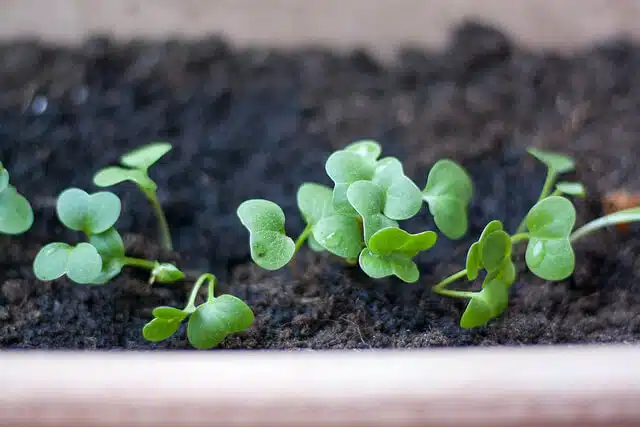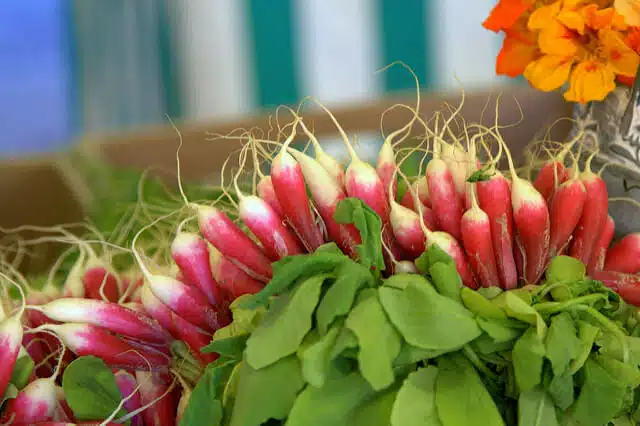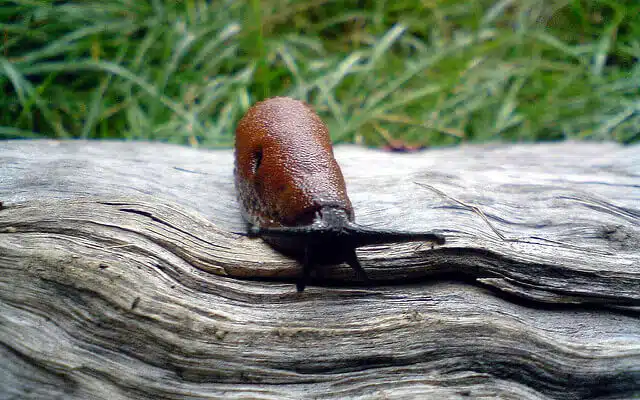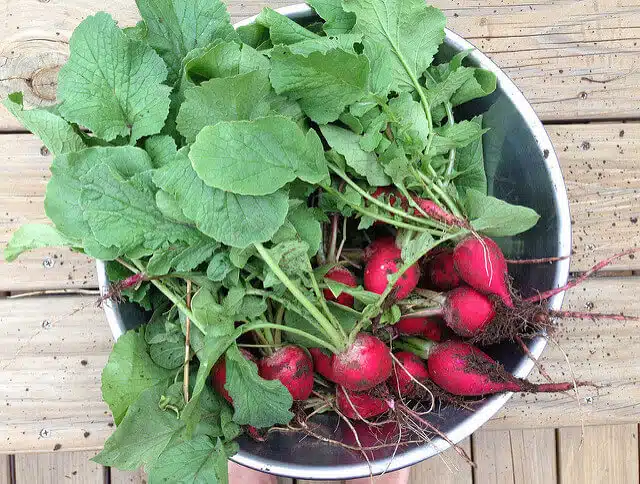Radishes are perfect for containers. They’re small, fast-growing and trouble-free. They don’t mind the shade and are happy in pretty much all conditions. The best varieties also taste fantastic.
So if you’re ready to start growing radishes, you’re in the right place. By the end of this article, you’ll know how to pick the best varieties (including a few unusual ones) and grow them to plump, spicy perfection.
One quick note before diving in: If you’re tempted to forgo radishes in favour of more “exciting” veggies – which is understandable if you have limited space – just remember you can always pop a few plants around the outsides of pots. They’re also great early and late-season crops, ideal for filling your space when it’s too cold or there isn’t enough light for other plants. Winter varieties are an excellent choice for later in the year.
Quick Page Navigation: Factsheet |Sowing & Harvesting Calendar | Potting Soil Tips | Sowing & Planting | Growing Tips | Harvesting | Storage & Eating | Pests & Problems | Varieties for Pots | More Resources
Factsheet
| Sprouting time: | 1 Week |
| Time from sowing to harvest: | 3 – 6 Weeks for Summer Varieties 2 – 3 Months for Winter Varieties |
| Size of pot: | Small |
| Difficulty of growing in pots? | Easy |
Sowing and Harvesting Calendar
- Sow: Late January to early August
- Harvest: January to December (all year)
Potting Soil Tips
- Generally speaking, radishes are unfussy when it comes to potting mix. I grew my first batch in store-bought peat potting soil without any added fertiliser.
- If you’re minded to give them a little extra love and care, add some drainage material like coarse (horticultural) sand or perlite. A handful of slow-release fertiliser will also be of benefit but don’t overdo it. One handful for a reasonably sized pot is more than enough.
- If you want to make your own potting mix, just follow a formula of 1/3 water-retaining material (limed peat or coir), 1/3 drainage material (just avoid very coarse drainage material and opt for sand or perlite) and 1/3 composted organic matter (manure or composted food scraps), with a little slow-release fertiliser added.
- If you don’t add any slow-release fertiliser, liquid feed at half-strength once the plants get going (after the first two weeks or so).
Sowing and Planting

- Sow summer varieties from February to June and winter varieties from July to August.
- You can plant sumer radishes quite closely, especially if you’re growing smaller varieties, which is a good option as a container grower. Leave about 3cm (1in.) between plants.
- Because young foliage can be a target for snails, slugs, birds, etc., I don’t recommend sowing directly into pots unless you’re starting plants early indoors, in which case sow profusely and thin out the strongest.
- My recommendation is to sow a few seeds in cheap alternatives to peat pots (like toilet roll tubes) and thin out before planting the makeshift pots directly into a larger container. Alternatively, you can sow in a seed tray and “prick out” the top performers.
Growing Tips

- If you’re growing early (spring) or late (autumn) in the season, then give radishes full sun. They’re a great filler plant for periods when little else will grow and generally unhampered by downy mildew.
- In summer, radishes actually prefer a little shade. Dappled shade is best so the outer edges of pots housing bigger plants are good locations.
- Keep them well-watered in hot weather. If you let the soil dry out, you might get a “woody” hollow texture. I did this one year and while the radishes were still edible, they were far from their best.
- If you haven’t added any slow-release fertiliser to your mix, feed with a generic liquid feed at half-strength once they’ve got going (usually a week or two after sowing). They’re not immensely hungry plants so don’t overdo it.
Harvesting
- Remember that you only need three to six weeks from sowing to harvest for summer radishes, depending which season you’re growing in (if you’re sowing early or late in the year, you’ll need a little longer). Winter radishes need between ten and twelve weeks.
- Summer radishes are ready to harvest when they’re around 1.5in. (4cm) in diameter. For round varieties (my favourite), about the size of a golf ball is a good measure.
- For longer, sausage-like varieties, cut the measurement above in half.
- Avoid leaving radishes to grow larger. They’ll end up hollow and lose some of their flavour. As I mentioned, I made this mistake the first time I grew them.
- Winter varieties will be ready for harvest from October to February and will be larger than summer varieties.
Storage and Eating
- My trusty Vegetable and Herb Expert by Dr. D G Hessayon describes an unusual way of eating radishes that was apparently the norm a few hundred years ago. Wash the roots and chop off the leaves such that a 1in. (3cm) stalk remains – this is your handle. Hold it by the stalk and eat the root with bread and cheese. Oh, and alcohol too!
- Another interesting tidbit: radishes are one of the oldest cultivated vegetables in the world and were given to pyramid-builders as sustenance.
- All that aside, the best way to enjoy radishes, in my humble opinion, is to thinly slice them and add them to salads.
- Also, remember that the leaves are edible! If they’ve been growing for a while, they won’t be suitable for salads but they’ll be fine in soup.
- Keep them in the fridge for up to ten days once harvested. They’re best eaten fresh.
Pests and Problems

Radishes are pretty much trouble-free, even more so when they’re grown in pots. There are one or two things to keep an eye on, however, especially if you’re growing in very early spring or late autumn.
- Birds – Birds can be a pest so a little netting or a bird scarer might be called for.
- Slugs and snails – These annoying visitors will feed on the leaves if given the chance, especially on younger seedlings. Start your plants indoors to avoid this problem.
- Downy mildew – Yellowing leaves with a thin, white, powder-like film (either on the surface or underside of leaves) likely indicate downy mildew. Remove affected leaves or, in bad cases, the whole plant. This is more of a problem when growing late or early in the year.
Good Radish Varieties for Pots
As far as varieties are concerned, most “red” types are suitable for containers (as opposed to white or black radishes). Generally, I would opt for globular varieties as they can tolerate limited root space.
Good varieties for US growers include:
- Cherry Belle – Available in both the US and UK, this lovely, sweet radish variety is ideal for container growers.
- Early Scarlet Globe – This variety is an old one (it’s been grown for at least 100 years) and has a mild flavour. I’d recommend growing them with Cherry Belle and seeing which you prefer.
- Pink Beauty – If you’re after a fast-growing radish variety, either to kick off the season or to make the most of those few weeks before light and warmth become practically nonexistent, then these are for you. They’re ready to eat in only 22 days.
- Black Round – An excellent winter variety that isn’t too big for pots.
Good varieties for UK growers include:
- Cherry Belle – A golf-ball shaped, sweet tasting variety that’s ideal for containers.
- Polenza – Another globe-shaped radish. It’s a heritage variety, so worth a try along with Cherry Belle.
- Mooli – A winter-hardy variety that isn’t too big.
More Resources
- Easy Radish Cookbook: 50 Delicious Radish Recipes – If you fall in love with this little vegetable (it’s always a risk), then invest in this cool book. The possibilities are endless…well, until you get to recipe number fifty.
- “Garlic Roasted Radishes” from The Real Food Dietitians – This is a wonderful little recipe and one of the best ways to eat radishes. Time your sowings so you have some fresh garlic to use.
- “Maple Roasted Radishes” from Green Evi – Another wonderful (and exceedingly tasty) little recipe.
- “Chive Mustard Roasted Radishes” from One Green Planet – If you aren’t already, consider growing chives (they’re perfect for containers) to go with the radishes in this recipe.
- A little primer on some of the more unusual varieties if you’re interested.
What are your thoughts? Leave a comment below!
Have you tried growing radishes in containers? Leave a comment below and let me know how it went!
Image credits: Fabio Rossi, Eric, OakleyOriginals, Jan Kaláb.

if using toilet paper rolls or paper towel rolls, how deep do they need to be? And can Cherry bell and/or french breakfast been sown to harvest in the rolls?
thank you
hi John, as long as the paper/cardboard is fully submerged in the soil it will adequately rot down. And I don’t see any issues with using toilet rolls for Cherry Belle and French Breakfast.